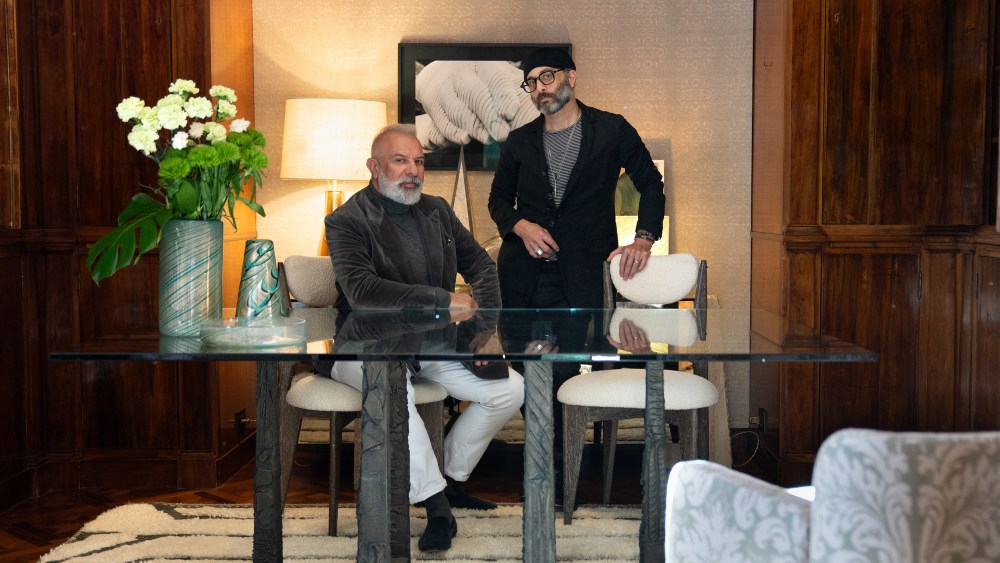MILAN — It’s been six years since Armenian Lebanese interior designer Chahan Minassian made Venice his new home. Since then, he’s injected his flair into Venetian jewels like Abbazia San Gregorio, a former Benedictine abbey and the home of Diane von Furstenburg in Palazzo Brandolini-Giustinian.
On Thursday, the founder of the famed Chahan Gallery in Paris told WWD he’s created his first textile collection with famed Venetian fabrics firm Fortuny. At the same time, Fortuny said it will launch its e-commerce business in tandem with the collection’s debut on Nov. 29.
It all started during the last Venice Art Biennale when Minassian was tapped to turn the former home of Countess Elsie Lee Gozzi at the historic Fortuny headquarters, into a gallery showcase of contemporary design. It was the first time the grandiose town house was open to the the broader design community and his first tailor-made textile creations with the brand were on display for all to see.
“Mickey [Riad] called and my answer was immediately yes. I design a million things and so designing fabrics was not an issue,” Minassian said in an interview, adding that it was an honor to be added to the Fortuny roster of collaborators with a capsule named “Armonia.” The collection includes variations with names like Hexa and Delphia — the latter is named after the original Fortuny fabric Delphi, which was designed by Fortuny’s founder in the early 20th century and was originally named after the ancient Greek city where the temple and theater of Apollo were located.

Hexa, one of the fabrics designed by interior designer Chahan Minassian for Fortuny.
Courtesy of Fortuny
Fortuny, whose iconic dresses like the Delphos were coveted by yesteryear icons like Isadora Duncan and Oona Chaplin, was founded in 1921 by artist and inventor Mariano Fortuny y Madrazo. His label continues to resonate worldwide for its innovative textiles and timeless designs that have been integrated into the collections of modern day designers like Rick Owens. Its legacy was revitalized by brothers Mickey and Maury Riad, the firm’s creative director and chief executive officer, respectively, who inherited the company from their father, Maged Riad, in 1998. Maged Riad had bought it from Countess Gozzi, Elsie McNeill Lee, the American interior designer who Mariano Fortuny had designated as his single representative in the U.S. McNeill Lee died in 1994.
Built on the grounds of an ancient convent, the company insists that the inner workings of the factory remain secret. According to the company, Fortuny y Madrazo’s will states that the techniques used to create the fabrics never be revealed publicly.

Fortuny Venice
Courtesy of Fortuny
Fortuny said the official launch of its latest textile collection is the ideal fusion of its heritage and Minassian’s layered, multicultural approach to design. It will be presented with a Minassian-designed display during Paris Deco Off, which will run from Jan. 15 to 18.
The step marks a new chapter for the brand. The collaboration was founded upon the idea of introducing contemporary elements that continue Fortuny’s relevance in today’s design landscape, Riad explained, adding that Minassian was a perfect fit for the project.
“We’re ready for the next chapter. We are working on having more finished pieces that clients can purchase and we are growing our e-commerce availability. We want people to bring a piece of Venice home, using our fabrics to create items that have a purpose and help elevate people’s environment,” Mickey Riad said, adding that the firm is constantly working on research and development of new techniques and new materials.
“Anyone will soon be able to purchase products we are creating online by going to our website. We haven’t discussed the retail collaborations yet but we are going to be launching our in-house products through our own channels,” he added.
The collection draws heavily from Fortuny’s extensive archives, reinterpreting historic designs with a fresh eye. New patterns, inspired by Minassian’s own work, include large-scale rhythmic motifs that reflect his belief in creating versatile, impactful pieces suitable for any space. These textiles are designed to be used together and can be assembled side by side to create different patterns.
The collection introduces new colors, new tonal combinations and a new bronze metallic. The palette incorporates colors drawing from Chahan’s signature of natural materials like rock crystal, slate, stone and bronze.
“I started with the DNA of one heritage fabric like the Delphi and transformed it to reflect my vision for the collection. I selected five patterns with several color options to diversify the palette” he said.
With newly designed showrooms in New York and Venice, Fortuny said it is poised to affirm its place as an iconic brand in luxury textiles. The launch of this collection is just the beginning for both Fortuny and Minassian.
“I would love to continue with more textiles,” Minassian said, adding that the Fortuny collaboration was “an excellent exercise made with the technical support of Fortuny.”
The historic Fortuny headquarters are located on the island of Giudecca in Venice and sit adjacent to the Fortuny factory facing the Giudecca Canal. Since the Biennale, the countess’ former home has partnered with Chahan Gallery as its exclusive Venice location. There, Minassian’s designs and unique pieces are on display and regularly replaced with new ones. On show in what he calls his “embassy” are Venetian glass sculptures, chandeliers, furniture pieces, walls and curtains draped in Fortuny fabric designs and much more.

